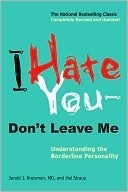More on this book
Community
Kindle Notes & Highlights
Read between
June 6 - December 3, 2020
Ask an experienced mental health clinician about the disorder, on the other hand, and you will get a much different response. She will sigh deeply and exclaim that of all the psychiatric patients, borderlines are the most difficult, the most dreaded, and the most to be avoided—more than schizophrenics, more than alcoholics, more than any other patient. For more than a decade, BPD has been lurking as a kind of “Third World” of mental illness—indistinct, massive, and vaguely threatening.
The lure of ecstatic experiences, whether attained through sex, drugs, or other means, is sometimes overwhelming for the borderline. In ecstasy, he can return to a primal world where the self and the external world merge—a form of second infancy.
When self-punishment becomes a prominent part of the psychodynamics, humiliation and masochistic perversions may enter the relationships. From this perspective, it is logical to speculate that many prostitutes and pornographic actors and models may be borderline.
A borderline may develop specific phobias as he employs magical thinking to deal with fears; sexual perversions may evolve as a mechanism to approach intimacy.
sexual perversions may evolve as a mechanism to approach intimacy.
The cult can be very enticing since it provides instant and unconditional acceptance, automatic intimacy, and a paternalistic leader who will be readily idealized.
Particularly when they are alone, borderlines may lose the sensation of existing, of feeling real. Rather than embracing Descartes’ “I think, therefore I am” principle of existence, they live by a philosophy closer to “Others act upon me, therefore I am.”
The borderline vacillates between a desire for closeness to relieve the emptiness and boredom, and fear of intimacy, which is perceived as the thief of self-confidence and independence.
The borderline lacks “object constancy,” the ability to understand others as complex human beings who nonetheless can relate in consistent ways. The borderline experiences another on the basis of his most recent encounter, rather than on a broader-based, consistent series of interactions. Therefore, a constant, predictable perception of another person never emerges—the borderline, as if afflicted with a kind of targeted amnesia, continues to respond to that person as someone new on each occasion.
The borderline experiences another on the basis of his most recent encounter, rather than on a broader-based, consistent series of interactions. Therefore, a constant, predictable perception of another person never emerges—the borderline, as if afflicted with a kind of targeted amnesia, continues to respond to that person as someone new on each occasion.
Afflicted with self-loathing, the borderline distrusts others’ expressions of caring. Like Groucho Marx, he would never belong to a club that would have him as a member.
Self-esteem is only attained through impressing others, so pleasing others becomes critical to loving herself.
Even sexual identity can be a source of confusion for the borderline. Some writers have noted an increased incidence of homosexuality, bisexuality, and sexual perversions among borderline personalities.
The borderline’s behaviors may be sudden and contradictory, since they result from strong, momentary feelings—perceptions that represent isolated, unconnected snapshots of experience.
For these borderlines, the body becomes a road map highlighted with a lifetime tour of self-inflicted scars.
In such instances the borderline may carefully scar body areas that are covered by clothing—which illustrates the borderline’s intense ambivalence: he feels compelled to flamboyantly self-punish, yet he carefully conceals the evidence of his tribulation.
Borderlines form a kind of insulating bubble that not only protects them from emotional hurt but also serves as a barrier from the sensations of reality. The experience of pain, then, becomes an important link to existence.
Lacking a core sense of identity, borderlines commonly experience a painful loneliness that motivates them to search for ways to fill up the “holes.”
The borderline frequently experiences a kind of existential angst, which can be a major obstacle in treatment for it saps the motivational energy to get well.
A stable sense of self cannot be established in an empty shell.
Some borderlines experience a kind of internal splitting, in which they feel different aspects of their personality emerge in different situations.
Many cases show an ongoing hostile or combative relationship between mother and pre-borderline child.
Because they are locked into a continual struggle to achieve object constancy, trust, and a separate identity, adult borderlines continue to rely on transitional objects for soothing.
Instead of adding layers of more self-condemnation, which allows him to continue to wallow in the muck of “woe is me,” he must instead confront the criticism and work to change.
Unfortunately, the borderline has difficulty grasping that she does not need to earn acceptance continuously. She is in constant fear that Support could be withdrawn if at any point she displeases. Thus, attempts at reassurance are never-ending and never enough.
She could see that no matter how hard she tried to run away from her feelings, she could not escape being herself. Even though she wanted to run away from the bad person she thought she was, she had to learn to accept herself, flaws and all.
The term borderline was first coined by Adolph Stern in 1938 to describe a group of patients who did not seem to fit into the primary diagnostic classifications of “neuroses” and “psychoses.”2 These individuals were obviously more ill than neurotic patients—in fact, “too ill for classical psychoanalysis”—yet they did not, like psychotic patients, continually misinterpret the real world. Though, like neurotics, they displayed a wide range of anxiety symptoms, neurotic patients usually had a more solid, consistent sense of identity and used more mature coping mechanisms.
Though borderlines may exhibit extreme empathy, warmth, and guilt, these exhibitions are often rote, more manipulative gestures for display purposes only, rather than true expressions of feeling.
The borderline’s identity is the consistency of Jell-O: it can be molded into any configuration that contains it, but slips through the hands when you try to pick it up.


